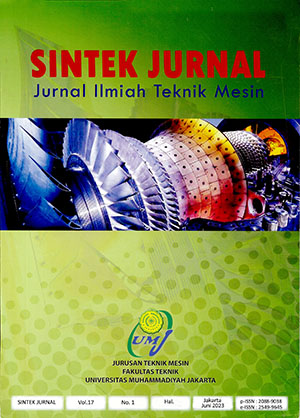Pengaruh sudut twist drill terdahap kekasaran dan kebulatan pada proses pemesinan drilling
Main Article Content
Abstract
Article Details
- Articles published in SINTEK JURNAL are licensed under a Creative Commons Attribution-ShareAlike 4.0 International license. You are free to copy, transform, or redistribute articles for any lawful purpose in any medium, provided you give appropriate credit to the original author(s) and SINTEK JURNAL, link to the license, indicate if changes were made, and redistribute any derivative work under the same license.
- Copyright on articles is retained by the respective author(s), without restrictions. A non-exclusive license is granted to SINTEK JURNAL to publish the article and identify itself as its original publisher, along with the commercial right to include the article in a hardcopy issue for sale to libraries and individuals.
- By publishing in SINTEK JURNAL, authors grant any third party the right to use their article to the extent provided by the Creative Commons Attribution-ShareAlike 4.0 International license.
References
N. H. B. Ambrizal, A. Farooqi, O. I. Alsultan, and N. Bin Yusoff, “Design and Development of CNC Robotic Machine Integrate-able with Nd-Yag Laser Device,” Procedia Eng., vol. 184, no. June, pp. 145–155, 2017, doi: 10.1016/j.proeng.2017.04.079.
M. H. Cetin, B. Ozcelik, E. Kuram, and E. Demirbas, “Evaluation of vegetable based cutting fluids with extreme pressure and cutting parameters in turning of AISI 304L by Taguchi method,” J. Clean. Prod., vol. 19, no. 17, pp. 2049–2056, 2011, doi: https://doi.org/10.1016/j.jclepro.2011.07.013.
N. K. Singh et al., “Performance of CuO nanoparticles as an additive to the chemically modified Nicotiana Tabacum as a sustainable coolant-lubricant during turning EN19 steel,” Wear, vol. 486–487, p. 204057, 2021, doi: https://doi.org/10.1016/j.wear.2021.204057.
K. K. Gajrani, P. S. Suvin, S. V. Kailas, K. P. Rajurkar, and M. R. Sankar, “Machining of hard materials using textured tool with minimum quantity nano-green cutting fluid,” CIRP J. Manuf. Sci. Technol., vol. 35, pp. 410–421, 2021, doi: https://doi.org/10.1016/j.cirpj.2021.06.018.
Affandi et al., “Atmospheric Corrosion Analysis on Low Carbon Steel Plate Profile and Elbow in Medan Belawan District,” Key Eng. Mater., vol. 892, pp. 142–149, 2021, doi: 10.4028/www.scientific.net/KEM.892.142.
C. Agrawal, J. Wadhwa, A. Pitroda, C. I. Pruncu, M. Sarikaya, and N. Khanna, “Comprehensive analysis of tool wear, tool life, surface roughness, costing and carbon emissions in turning Ti–6Al–4V titanium alloy: Cryogenic versus wet machining,” Tribol. Int., vol. 153, p. 106597, 2021, doi: https://doi.org/10.1016/j.triboint.2020.106597.
A. R. Nasution, Z. Fuadi, I. Hasanuddin, and R. Kurniawan, “Effect of vegetable oils as cutting fluid on wear of carbide cutting tool insert in a milling process,” IOP Conf. Ser. Mater. Sci. Eng., vol. 796, no. 1, 2020, doi: 10.1088/1757-899X/796/1/012001.
M. Varatharajulu, M. Duraiselvam, M. B. Kumar, G. Jayaprakash, and N. Baskar, “Multi criteria decision making through TOPSIS and COPRAS on drilling parameters of magnesium AZ91,” J. Magnes. Alloy., 2021, doi: https://doi.org/10.1016/j.jma.2021.05.006.
K. Mouralova, J. Bednar, L. Benes, T. Plichta, T. Prokes, and J. Fries, “Production of precision slots in copper foil using micro EDM,” Sci. Rep., vol. 12, no. 1, p. 5023, 2022, doi: 10.1038/s41598-022-08957-9.
L. Wei and D. Wang, “Comparative study on drilling effect between conventional drilling and ultrasonic-assisted drilling of Ti-6Al-4V/Al2024-T351 laminated material,” Int. J. Adv. Manuf. Technol., vol. 103, no. 1, pp. 141–152, 2019, doi: 10.1007/s00170-019-03507-6.
L. N. López de Lacalle et al., “Monitoring deep twist drilling for a rapid manufacturing of light high-strength parts,” Mech. Syst. Signal Process., vol. 25, no. 7, pp. 2745–2752, 2011, doi: https://doi.org/10.1016/j.ymssp.2011.02.008.
S. Bhattacharyya, H. Chelladurai, and M. Z. Ansari, “Effect of Micro-milling Parameters on Surface Roughness of Soft Metal Cutting and Their Regression Models BT - Recent Advances in Manufacturing, Automation, Design and Energy Technologies,” 2022, pp. 221–228.


